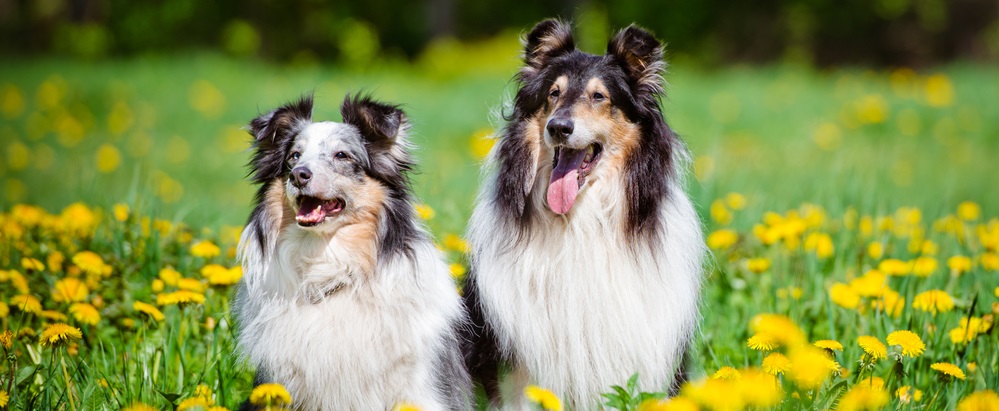Hot spots are a skin condition that can be quite common among dogs but, if unfamiliar to you, can set off all kinds of protective, paw-parent alarm bells.
Everyone knows that a dog is more than just a cute cuddle companion. It’s a beloved extension of your family whose health is just as important to you as your own. So, when an unrecognizable skin infection seems to pop up out of the blue, doing research to find out what it is and how you can treat it is second to none.
Good news: You’ve come to the right place.
Below you’ll find information about what a dog hot spot is, how to recognize and treat it, and the steps you can take to ensure they don’t happen again.
Defining and Recognizing a Hot Spot
So, what is a hot spot in dogs? While its name may lead you to believe that your dog is harboring some sort of volcanic activity beneath its skin, it’s not quite so dramatic.
It can, however, be identified by a slow-oozing fluid that emerges from a point of infection, similar to the way lava flows from a crater. (Save yourself from the Google image search results, and trust this imagery instead.)
Hot Spots Defined
Hot spots, also known as pyotraumatic dermatitis or acute moist dermatitis, are skin problems that can occur as a result of excessive irritation to a specific area of your dog’s body. They can be commonly found on the head, limbs, or neck of your animal, and they’re often quite painful and itchy.
Unlike an insect bite that will fade over time, hot spots can quickly worsen and expand if left untreated.
 How to Recognize a Hot Spot
How to Recognize a Hot Spot
Since occasional red spots and itchiness are common among canines, it can be easy to overlook them in their infant states. Small, irritated patches can go undetected by most dog owners, especially if their pet is a long-haired breed.
Do you think your dog may be suffering from acute moist dermatitis? Here are a few possible hot spot indicators that owners can keep an eye out for:
- Redness and swelling
- Loss of fur in select areas
- Scabbing
- Open sores
- Bleeding or discharge
- Unpleasant odor near the wound site
- Damp, matted hair
Do any of these seem to describe the abnormality you’ve noticed in your pet?
If so, it may be a good time to contact your local veterinarian to have a closer examination. If you’re unsure, it’s best to keep an eye on your pup and try to prevent any further skin irritation by discouraging them from scratching or licking the infected area in excess.
Why Hot Spots are a Problem
Although they’re not necessarily a life-threatening emergency, hot spots can still be quite problematic for a couple reasons. Similar to poison ivy irritation in humans, the aggravation of hot spots can be both relieved and worsened by continuous itching. If unable to find an alternative form of relief, dogs may attempt to self-soothe by licking or scratching which will only lead to more discomfort.
Additionally, if the hot spot develops into an open lesion it may become susceptible to other types of more serious bacterial infections. Although they’re often localized to one area of the body, in more severe cases hot spots can spread across all parts of an affected animal.
Be sure to keep careful watch over your dog’s behavior and perform regular checks to avoid any of these additional risks.
Pinpointing the Source of Hot Spots
Defining the main causes of hot spots is one of the best ways to ensure they don’t become a recurring problem for your pet. Not exactly sure what causes hot spot on dogs? Generally, this type of skin irritation thrives in high temperatures and heavy moisture. Certain breeds may also find themselves more susceptible to hot spots, particularly if they have long, thick fur.
Dog types that are commonly affected by hot spots include:1
- Golden retrievers
- German shepherds
- Saint Bernards
- Collies
Hot spots may also be caused by several other factors related to things like an allergic reaction and insect bites. Again, accurately identifying the root cause of acute moist dermatitis will go a long way in ensuring it doesn’t happen again, saving your pup from any future discomfort and yourself from an extra trip to the vet.
Here are some of the most common causes of hot spots in dogs:
- Lingering moisture after a swim or bath
- Flea bite sensitivity
- Excessive licking as a result of boredom or stress
- Ear infections
- Food or seasonal allergies
- Inflamed anal gland
- Parasites such as sarcoptic mange2
Consult with your veterinarian in order to pinpoint the most likely cause of irritation and, once diagnosed, move forward with a proper treatment plan from there.
Treating a Hot Spot
Now that you’re certain that your pup’s excessive scratching and crusty, red skin patch is not just an insect bite they’ll recover from in a day or two, you’ll need to schedule a visit with your veterinarian to properly diagnose the issue and determine the best form of treatment.
In some cases, vets will perform a skin cytology to determine if the lesion turned into an infected hot spot on your dog. Depending on the findings and the severity of your dog’s case, some treatments will follow different trajectories than others.
Dogs suffering from mild to moderate cases of hot spots will typically undergo treatment plans including the following:
- Clipping the fur surrounding the irritated area – Whether you can carefully perform this at home with clippers specifically designed for pet hair or if you’d prefer to entrust your vet with this task, clearing the hot spot of any irritants, like fur, is essential to the healing process.
- Wearing a recovery collar– If your dog has hot spots and can’t seem to stop licking or scratching them, the vet may suggest wearing a recovery collar (the dreaded cone of shame) to prevent further harm.
- Cleaning the affected area – Using our antibacterial shampoo or a gentle antiseptic are just a couple of options available to keep the site clean of any dirt, sweat, or grime that could cause symptoms to worsen.
- Applying a topical spray or gel – An antimicrobial hot spot spray that is safe for use around the eyes, nose, ears, and mouth of your dog may be applied three to four times daily until the symptoms show signs of improvement. Additionally, an antimicrobial hydrogel can also be used in conjunction with a hot spot spray for any hard-to-reach areas and for additional protection.
In more serious cases, vets may prescribe oral steroids or antibiotics to be taken over the course of three to four weeks. In most instances, owners can expect to see improvement in their pets’ conditions between three and seven days after the start of regular treatment.
Preventing a Hot Spot
Now that your favorite canine companion has fully recovered from a bout with hot spots, let’s make sure they don’t come creeping back any time soon. Once you’ve identified the root cause of your pet’s hot spots, your next steps should include finding the best ways to manage them.
Follow these preventative measures to keep your pet safe, comfortable, and hot-spot-free:
- Practice regular grooming – Hygiene is just as important for dogs as it is for humans. Keep your fur baby clean by scheduling regular grooming sessions with your local groomer or by rolling your sleeves up and taking care of it at home. Consider a medicated shampoo to bolster your pet’s natural immune system to help fight off any future skin issues.
- Stay dry – Damp dogs can be a breeding ground for all sorts of unwanted skin ailments. After each at-home bath or, if your dog is an active swimmer, be sure to dry them off completely to combat any kind of moisture-loving bacteria.
- Practice regular exercise – Some dogs will find themselves itching and licking excessively just to pass the time. Are you and your dog able to carve out more time in your schedule for exercise and play? Staying active is important for your dog’s overall health, not just for fighting off hot spots. Consider hiring a dog walker to come a few times a week so they can stretch their legs a bit more.
- Identify and treat allergies – Does your dog have some kind of food or environmental allergy? If you’re not sure, consider getting them tested to weed this out as a possible cause of hot spots. Getting them access to the proper diet or allergy medications they need could be an effective strategy in preventing future flare-ups.
Keep Hot Spots Under Control With Vetericyn
Rest assured, hot spots are a common problem among pets and, most of the time, are easily treatable. But that doesn’t mean you shouldn’t continue to do your part as a pet owner to make sure they don’t become a recurring issue.
Vetericyn cares for your animals just as much as you do, which is why we’ve created a select line of pet products specially crafted to treat and prevent an array of dermatological problems. Not only are they soothing against aggravating itches, but they are also safe if ingested. Noticing similar symptoms in your cat? At Vetericyn we are here to assist you with understanding what causes hot spots in cats along with the best cat hot spot treatments.
Keep your pet’s hot spots at bay and your mind at ease with Vetericyn.
Sources:
- Clinician’s Brief. Acute Moist Dermatitis. https://www.cliniciansbrief.com/article/acute-moist-dermatitis
- PetMD. Sarcoptic Mange in Dogs. https://www.petmd.com/dog/conditions/skin/c_dg_sarcoptic_mange
- American Kennel Club. Treating and Preventing Hot Spots on Dogs. https://www.akc.org/expert-advice/health/treating-and-preventing-hot-spots-on-dogs/



